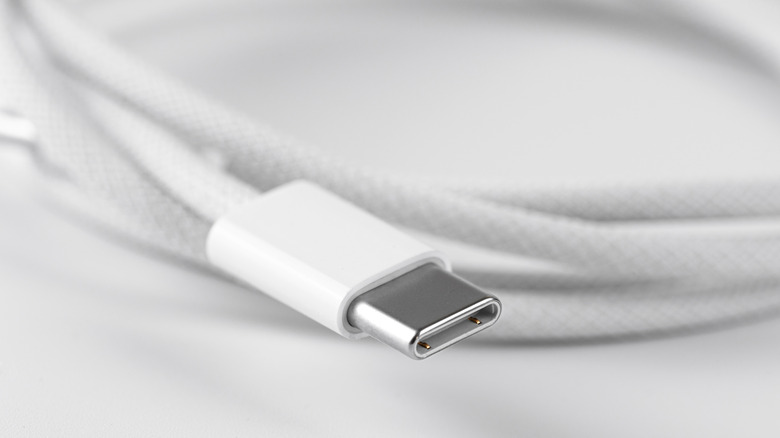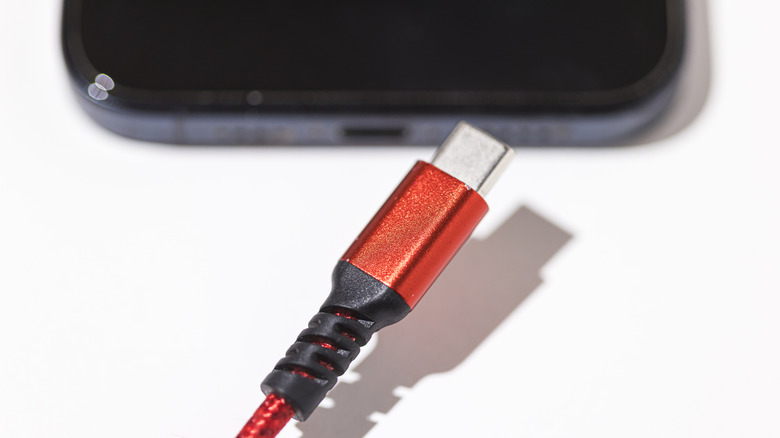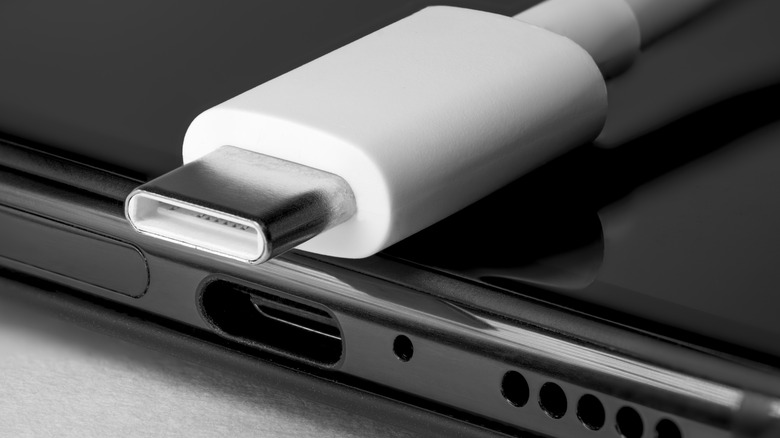What's The Difference Between USB-C And USB4?
If you, like most people, have a drawer full of USB cables for all your different devices, then you know how quickly those cables can get out of hand. However you organize your cables, keeping track of the different types can require a course in tech jargon just to make sense of it all. Two of the terms you've likely come across are USB-C and USB4, especially if you've been out shopping for new tech recently. Most of us are at least somewhat familiar with USB-C and what it can do, but if we throw USB4 in the mix, things can start to get confusing, especially since they share the same connector.
While you'll often see USB-C and USB4 listed side by side on packaging and spec sheets, they're not interchangeable. USB4 refers to the technology standard, while USB-C describes the physical shape of the connector. In other words, when we talk about USB-C, we're referring to the design of the connector itself: the small, reversible plug that you see at the end of the cables you use for everything from charging your phone to connecting accessories like external drives and monitors. However, just because two cables share the same connector doesn't mean they deliver the same performance; that's where USB4 comes in. USB4 is a technology standard that uses the USB-C connector to deliver faster speeds, better power delivery, and more advanced features.
USB-C is just the connector, but performance varies widely
Whether you're charging the brand new MacBook Air M4 or the Samsung Galaxy S25 Ultra, you're plugging your device into a USB-C port. Over the past few years, the compact, rectangular-shaped reversible connector has become the standard across modern tech, replacing older USB-A and USB-B ports. From laptops and tablets to smartphones and wireless earbuds, if you bought a new device in the last couple of years, there's a good chance it has a USB-C port. And that's what makes the USB-C connector so special: it has a universal port shape that's easy to plug in and supports a wide variety of devices and functions, including charging, data transfer, and even video output.
As convenient as this universal connector is, there's a catch: USB-C only describes the shape of the connector; it says nothing about its speed, charging capability, or features. For example, that USB-C cable you're using to charge your device may only support slow USB 2.0 speeds, or it may support much faster USB 3.2 or USB4 speeds; it all depends on the cable's specifications and the standards it supports.
Some USB-C cables are even charge-only, meaning they don't support data transfer at all. In other words, the USB-C cable you're using could be limited to basic power delivery or support high-wattage charging for laptops. It's this variation that makes USB-C so confusing for many people. You can be staring at two seemingly identical cables, and one charges your device rapidly while the other moves at a snail's pace and doesn't even support data transfer.
How USB4 improves performance over older USB-C standards
While USB-C describes the physical connector, USB4 refers to the technology standard that uses it. Introduced in 2019, USB4 is a major upgrade over previous USB technology, offering faster speeds, better power delivery, and built-in support for Thunderbolt features. That said, just because a device uses a USB-C connector doesn't guarantee it supports USB4; you'll need to check the specs carefully. If you're using a USB-C connector that supports USB4, you'll get data transfer rates of up to 40 Gbps, which is almost double what USB 3.2 Gen 2 can provide. That means you'll be able to move your large files a lot faster, stream high-resolution video, or connect multiple monitors through a single port and not worry about lag.
USB4's capabilities go beyond just delivering faster speeds; it also improves power delivery, supporting up to 100 watts, which is something you'll find especially useful if you have large devices like laptops that need to be charged. Another important feature is its compatibility with Thunderbolt 3 or later, which makes it possible to use high-speed accessories like external monitors, docks, and storage drives through the same USB-C port. Getting to know the difference between Thunderbolt and USB-C can be helpful in making sure you get the right cable or accessory for your device, as well.


